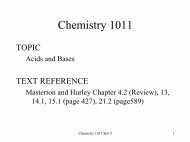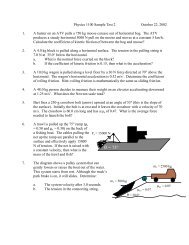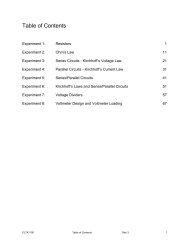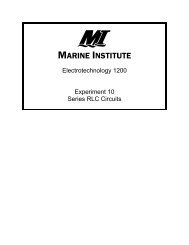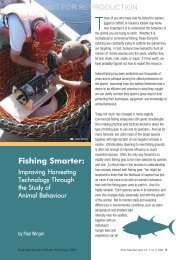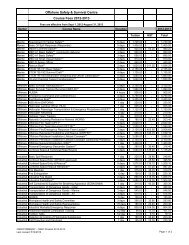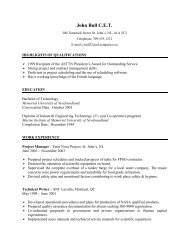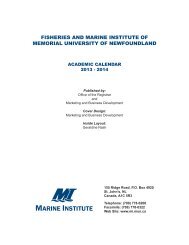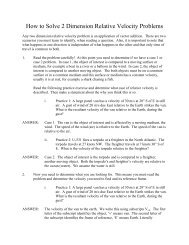Lab 8
Lab 8
Lab 8
- No tags were found...
You also want an ePaper? Increase the reach of your titles
YUMPU automatically turns print PDFs into web optimized ePapers that Google loves.
Electrotechnology 1200Experiment 8Power in Series RL/RC Circuits
SAMPLE CALCULATIONSELTK1200 Experiment 8 Rev 5 90
BASIC INFORMATIONThe phasor diagram and impedance triangle for a series RL circuit look like this:The power triangle for a series RL circuit lookslike the drawing on the right.θ is common to all three drawings, so they areall proportional. If you know 3 or 4 of thevariables (i.e. V S , I and θ), you can calculate all11 shown on the drawings. In many cases, youcan use these relationships to perform selfchecksupon your solutions to problems.This Experiment attempts to prove that thepower triangle is equivalent to the phasordiagrams and impedance triangles drawn inExperiments 5 and 7.OBJECTIVESWhen you have completed this exercise, you should be able to:CCCCalculate real and apparent power for series RL/RC circuits.Determine the power factor for series RL/RC circuits.Draw the power triangle for series RL/RC circuits.ELTK1200 Experiment 8 Rev 5 91
FORMULAEIn the following formulas .Formula 35.Formula 36.Formula 37.Formula 38.Formula 39.EQUIPMENT & MATERIALS REQUIREDOscilloscope.2 BNC to Alligator Clip test leads.2 Black Alligator Clip to Banana Plug test leads.2 Red Alligator Clip to Banana Plug test leads.Isolation transformer (Black).Variac (Blue).Fused Line Cord Board (stored in Drawer 4 and 22).• Orange Project board with line cord and fuse attached.DMM (Digital Multimeter).Analog AC Ammeter.0.47μF capacitor.8H choke.4.7kΩ resistor.5.6kΩ resistor.Miscellaneous Quick Clips.ELTK1200 Experiment 8 Rev 5 92
WHAT YOU SHOULD KNOWBy this point in the course, you should be familiar with the basic formulas. To help yougain confidence, the Procedure will no longer tell you which formula to use. Generalpurpose formulas that you will need will be contained in a new section called Formulae.You will be expected to choose the appropriate formulas to complete your calculations.As you go through the Procedures, try to determine the formula to use based upon theinformation. If you do not know which formula to use on your own, refer back to theFormulae Section to get a clue.Specific formulas, that must be used, will still be provided in the Procedure.PROCEDURE A (Determining Power Using Voltage-Current)A1. Measure the actual resistance of the 4.7kΩ and 5.6kΩ resistors [8-1].A2. Connect the Isolated Variable ac Power Supply circuit shown in Figure 2-1 (pg. 17)to the circuit of Figure 8-1. Prepare to measure I and V AB or V R .A3. Turn the Variac ON. Set V AB = 10V.A4. Measure I and V R [8-2].Figure 8-1A5. Calculate the Apparent Power S, the Real Power P, the Reactive Power Q L (or Q C )(Formula 40), the phase angle θ and the power factor pf of the circuit [8-2]. Makesure you say whether the pf is leading or lagging.Formula 40.ELTK1200 Experiment 8 Rev 5 93
A6. Set V AB = 20V. Repeat Steps A4 and A5.A7. Set V AB = 30V. Repeat Steps A4 and A5.A8. Turn the Variac OFF.A9. Connect the Isolated Variable ac Power Supply circuit shown in Figure 2-1 (pg. 17)to the circuit of Figure 8-2. Prepare to measure I and V AB or V R .Figure 8-2A10. Repeat Steps A3 to A8.ELTK1200 Experiment 8 Rev 5 94
PROCEDURE B (Determining the power factor with anOscilloscope)B1. MODE to DUAL, SOURCE to LINE and PULL INVERT is pushed IN.B2. Connect the Isolated Variable ac Power Supply circuit shown in Figure 2-1 (pg. 17)to the circuit of Figure 8-3. Prepare to measure V AB and V R PP vs V AB PP .B3. Turn the Variac ON. Set V AB = 10V.Figure 8-3B4. Using the procedure described in Experiment 5, Steps C4 to C21, measure thephase angle between V R PP and V AB PP . Measure D and d, calculate θ and the powerfactor pf [8-3]. Make sure you say whether the pf is leading or lagging.Note: your value of θ should be consistent with the corresponding values in Table8-2.B5. Turn the Variac OFF.ELTK1200 Experiment 8 Rev 5 95
B6. MODE to DUAL, SOURCE to LINE and PULL INVERT is pushed IN.B7. Connect the Isolated Variable ac Power Supply circuit shown in Figure 2-1 (pg. 17)to the circuit of Figure 8-4. Prepare to measure V AB and V R PP vs V AB PP .Figure 8-4B8. Turn the Variac ON. Set V AB = 10V.B9. Using the procedure described in Experiment 5, Steps C4 to C21, measure thephase angle between V R PP and V AB PP . Measure D and d, calculate θ and the powerfactor pf [8-3].Make sure you say whether the pf is leading or lagging.B10. Turn the Variac OFF. Disconnect your circuit and return all equipment to its properplace.ELTK1200 Experiment 8 Rev 5 96
RESULTSTable 8-1Coded Value 4.7 kΩ 5.6 kΩ StepTIPPhase angle:.45E for d1 <strong>Lab</strong> QuizMeasured ValueA1Table 8-2V ABmeasImeasV RmeasScalcPcalcQ L /Q CcalcθcalcpfcalcR4.7kΩL8H10V20V30VdddR5.6kΩC0.47μF10V20V30VdddStep A3,6-7 A4 A5Table 8-3DmeasdmeasθcalcpfcalcStepV R vs V AB 1R4.7kΩL8HdB4V R vs V AB 1R5.6kΩC0.47μFdB9ELTK1200 Experiment 8 Rev 5 97
QUESTIONS1. Using the data from Table 8-2 for V = 30V, draw the power triangles for the RL andthe RC circuits.2. What is the difference between real power and apparent power in an ac circuit?3. Using your data in Table 8-2, does the pf or phase angle of an ac circuit dependupon voltage or current?4. A load has a power factor of 0.7 lagging. What does this mean with reference to linevoltage (V AB or V S ) and current (I)?ELTK1200 Experiment 8 Rev 5 98



